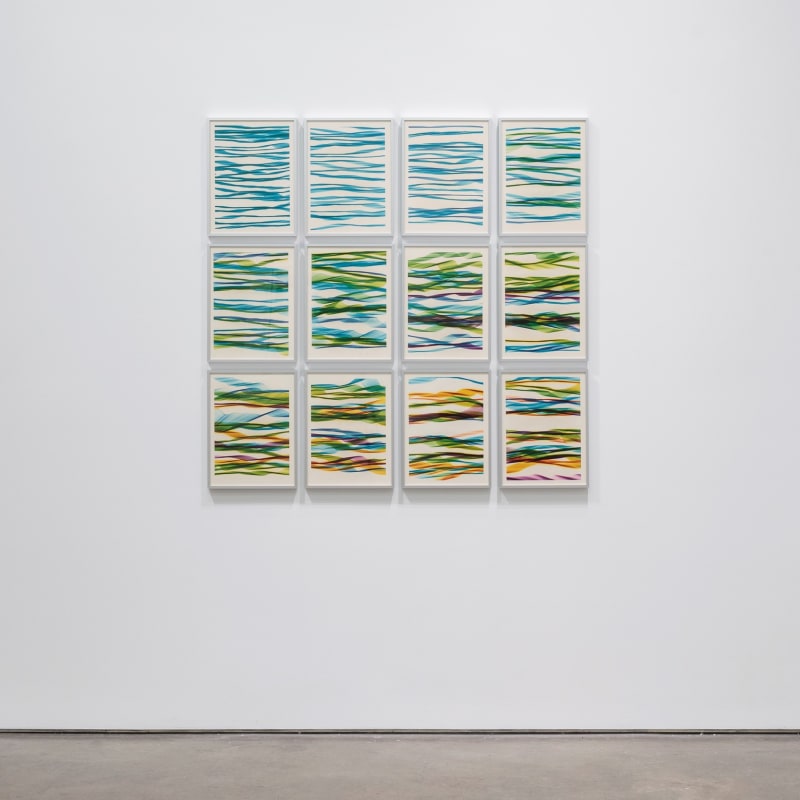JTF (just the facts): A total of 12 color photographic works by Holzhäuser, framed in white and unmatted, and hung against white walls in the East gallery space. All of the works are colored light on PE-color paper, made between 1985 and 1993. 7 of the works consist of two panels, each 24×20 inches. The other works include 3 single panel works (24×20 inches), a triptych of three panels (each 20×20 inches), a set of four prints (each 20×16 inches), and a set of 12 prints (each 16×12 inches). All of the works are unique.
The main show is supported by an additional group show, entitled Painting with Light, which is on view in the West gallery and in the connecting hallway.
Comments/Context: For most of us, making a photograph is an externally-driven activity. We use a camera to look outward, to see the world, and to document what we find there.
But for a few artists, photography itself can become an all-encompassing subject. They instead look inward, to the optics and properties of light that generate an exposure, to the complex mechanics of the camera itself, and to the activities in the darkroom that result in a physical print. Among the strictest practitioners of this kind of approach were the artists of the Concrete Photography movement (beginning in the 1960s in Germany and continuing forward until today to some extent), who wanted to remove any kind of representation from the aesthetics of photography and reduce it back down to its internal essence – the controlled application of light.
The subject of this exhibit, Karl Martin Holzhäuser, has been a key figure in the movement, and as the works on view here show, his techniques have consistently been boldly experimental, albeit within his own tight parameters and imposed rules. Many were crafted in the darkroom, using a lichtrakel (“light rake”), a long hand-held device of his own invention, like a tube with a lengthwise slit from which light was emitted. The results depended on how Holzhäuser moved the device across light sensitive papers (often two adjacent panels, arrayed vertically), how he used various gels and filters to generate color, how he masked the device to create areas of striping, and how long he took to make his gestures, and these seemingly limited options offered a surprisingly wide range of possibilities for abstraction.
The seven works hung along a single wall provide resonant examples of the outcomes. When Holzhäuser moved the light rake in straight lines, or doubled back on himself with back and forth motions, he alternately created flat fields, zig zagged forms, or overlapped folds and tight pleats. When he kept one end steady and moved the other more freely, he generated conical shaped fans that seem to spiral inward. And other less obvious gestures led to concave swoops, stuttering waves, and twisting vortices, each one executed in the dark, like the meticulous choreography of a dance. Many of these works also play with intricate combinations of tinted colors, or careful stripes that march in lock step, the time spent leading to nuances in the depth of the transparency of the colors.
The other works in the show utilize alternate techniques. In one set of 12 prints, Holzhäuser used a can with a light inside and different shaped holes in the bottom to generate wispy lines of intermingled color that flutter like ribbons. 3 others pair a gel color sample with the artist’s attempts to match it, the delicate fan-shaped forms seeming to undulate in a soft wind. Still others play with alternating strips of color, testing the aesthetic properties of squiggled horizontal striations and varying thicknesses, moving from one pair to several in a step-wise progression. In each case, we can almost watch the artist’s mind turning, searching for the place where the chosen innovation reaches its limits.
The back gallery houses a sampler-style group show of works by artists similarly interested in the photographic play of light. Gottfried Jäger, another important member of the Concrete Photography movement, is represented by a clustered group of photo strips, each a slightly different shade between white and black, the resulting pile a jumble of overlapped rectangles.
Several other contemporary artists have taken similarly elemental approaches to experimenting with and unpacking light. Works by Jessica Eaton, Ellen Carey, and Assaf Shaham smartly investigate transparent films, additive color, and reflection, Shaham bringing a paired set of scanners into the technological mix. Actually “drawing” with light is represented by images from Harry Callahan, Gjon Mili (with Picasso making the gestures), and Alison Rossiter, while the physical burning effects of too much intense light are explored by Chris McCaw and Marco Breuer. And photogram techniques of various kinds are employed by many of those included, bringing silhouetted, layered, and constructed representation (either straightforward or more mysterious) back into the aesthetic equation. Seen together, a well-edited and informative contemporary spread of light-based techniques emerges, putting the structured work of Holzhäuser in a robustly complex context.
The strict principles of the Concrete Photography artists lead some of the resulting work to feel quite theoretical and scientific, the iterations and permutations of light turned into conceptual instructions, systematic tests, and visual proofs that can be dry and imposing. But the selection of Holzhäuser’s works in this show gets beyond that rule following, extending into areas where gesture and improvisation give the images lightness and vitality. The best of the works here are both intellectually impressive and joyfully unexpected, the deconstruction of the process opening up new doors for aesthetic innovation.
